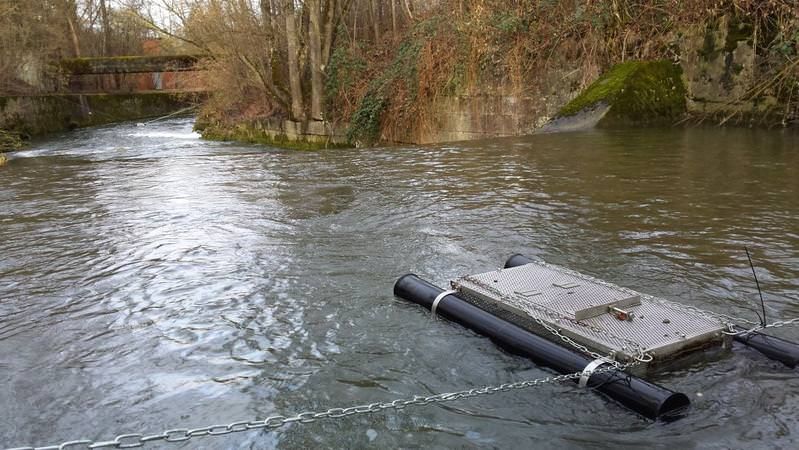Impact of Different Wastewater Treatment Technologies on Effluent-exposed Fish
Published on by Water Network Research, Official research team of The Water Network in Academic
Evolutionary biologists from the University of Tübingen investigate how water treatments affect fish
Even tiny amounts of toxins in rivers and lakes can endanger aquatic organisms. The public has become more aware of this environmental problem in recent years. Trace amounts of toxins found in our waterways are included in many of the things we use every day – dishwasher tablets, washing powder and shower gel – as well as pharmaceuticals, cosmetics, and pesticides.

The researchers kept rainbow trout in a special cage in the waters they were analyzing. Photo: Rita Triebskorn
These substances are in household wastewater and are transported to wastewater treatment plants, where conventional techniques cannot completely remove or degrade them. The treated wastewater flows into our streams, taking the toxins with it. A group of researchers headed by the University of Tübingen’s Professor Rita Triebskorn has been investigating the effects of various wastewater treatments on the health of fish.
The scientists, from the Institute of Evolution and Ecology (EvE), found that the type of wastewater treatment needs to be decided on a case by case basis, depending on the composition of toxins in the wastewater. Their study has been published in the journal Environmental Sciences Europe.
In conventional wastewater treatment plants the wastewater from industry and private households runs through mechanical, biological, and chemical purification stages. Additional stages using activated carbon or ozonisation are increasingly being included as a fourth purifcation stage. “As part of an investigation on Lake Constance we were able to show that trace toxins can be effectively removed with an additional stage of powdered activated carbon, and that the health of aquatic organisms in the area clearly improves,” says Rita Triebskorn. “But until now there have been relatively few studies on the long-term success of improved wastewater treatment on water ecosystems.”
Standardized experimental conditions
In their comparative experiments the researchers looked at three conventional wastewater treatment plants – one of which, the Langwiese plant in the Ravensburg district, had an activated carbon stage installed during the study. The biologists placed cages into the water above and below the place where treated water from the plant flowed into the river. “Compared with the examination of wild fish, this has the advantage that we can standardize the fish characteristics such as age, diet and stage of development. This means we can better recognize any effects on the health of the animals,” says team member and the study’s corresponding author, Sabrina Wilhelm. Established methods were used to find out whether the rainbow trout cell nuclei showed signs of increased genotoxicity. And the livers of the fish were examined to determine whether they were having to work harder to remove or break down toxins.
Case-by-case decisions
“While we didn’t find negative effects of trace toxins on fish health in one of the conventional water treatment plants, the rainbow trout below the second conventional plant had much higher critical liver values,” Sabrina Wilhelm says. “We also saw these negative effects at the Langwiese plant before the installation of the fourth stage.” She adds that the activated carbon stage clearly reduced the high liver values and the genotoxicity in the fish.
“Investing in modern water purification techniques are a boon to aquatic ecosystems particularly when conventional technologies don’t do enough to reduce the levels of toxins,” Rita Triebskorn says. “However, depending on the composition of the wastewater, negative effects on aquatic organisms can also be reduced by optimizing conventional wastewater purification.” The bottom line is that it is worth investing in good wastewater purification for sustainable protection of our environment.
Publication: Sabrina Wilhelm, Stefanie Jacob, Michael Ziegler, Heinz-R. Köhler, Rita Triebskorn: Which kind of wastewater treatment do we need to avoid genotoxicity and dioxin-like toxicity in effluent-exposed fish? . Environmental Sciences Europe, https://doi.org/10.1186/s12302-018-0154-0.
Source: University of Tübingen
Media
Taxonomy
- Wastewater Disposal
- Effluent
- Reclaimed Wastewater
- Industrial Wastewater Treatment
- Industrial Water Treatment
- Industrial
- Wastewater Treatment
- Ecosystem Management
- Wastewater Treatment Plant Design
- Ecosystem Management
- Animal Health